The Microsoft Surface Pro (2017) Review: Evolution
by Brett Howse on June 15, 2017 9:00 AM ESTGraphics Performance
With the Core i7-7660U, we finally get a chance to look at the Intel Iris Plus Graphics 640 in a notebook. On a typical U series Intel Core processor, there are 24 execution units (EUs) available, but the Iris Plus doubles that to 48. Despite having the same TDP, having twice as many EUs running should still be a big boost to performance, as even if they need to throttle, there are twice as many, so they can run slow and wide and still fit in the TDP. The base frequency for the graphics is 300 MHz, with a 1.1 GHz boost frequency.
The addition of 64 MB of eDRAM is also a large benefit to graphics, which needs a lot more memory bandwidth than the CPU, and having this extra eDRAM as a cache for the GPU is a big benefit to the Iris Plus graphics.
In the graphs below, make note that the Dell XPS 15 has a GTX 960M graphics card, which should win pretty handily, but the Surface Book has a smaller GT 940M with 2 GB of GDDR5, so it will be interesting to see the performance difference between the integrated Iris Plus Graphics 640, and a discrete entry-level GPU.
3DMark
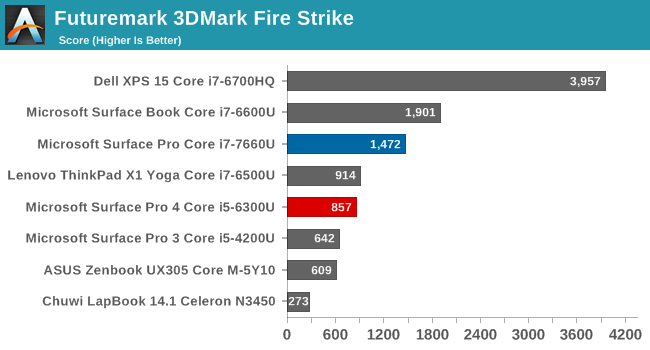
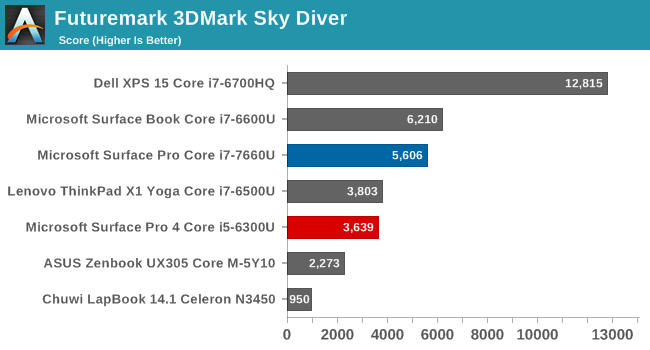


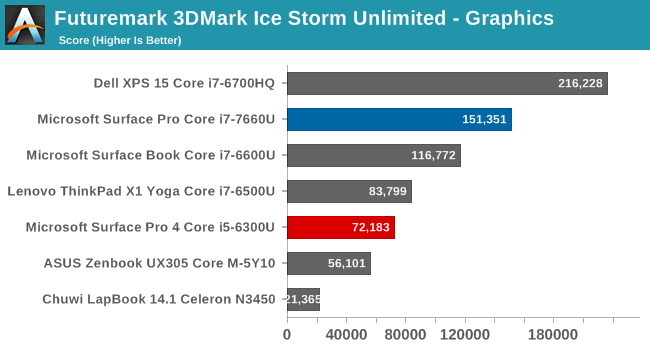
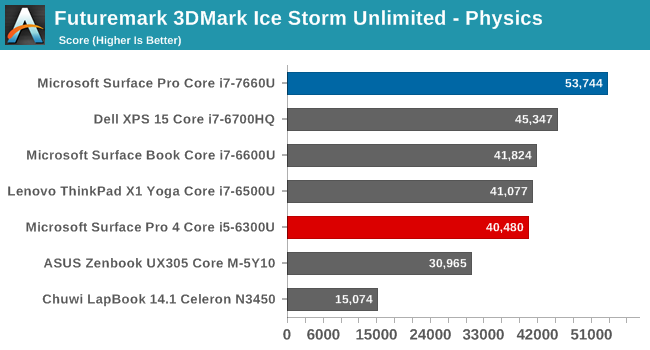
Futuremark’s 3DMark continues to be developed, and new tests have been added for higher end systems, but for our purposes on this review, the normal results will do just fine. Each of the tests move from quality to performance, with Fire Strike being the most demanding, and Ice Storm Unlimited being a smartphone or tablet test. The GT 940M in the Surface Book still manages to hold an edge on the more graphically demanding tests, but is then surpassed as the workload gets easier, and the test becomes more CPU bound. Compared to the non-Iris Ultrabooks though, the i7-7660U delivers a lot more performance.
GFXBench
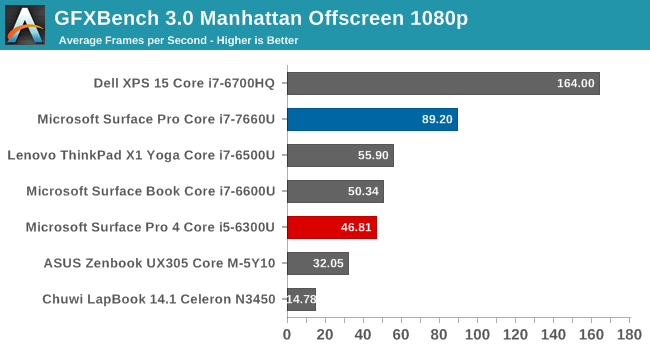

Another synthetic, Kishonti’s GFXBench also continues to evolve, with new tests being added to provide more stressful tests than the older T-Rex and Manhattan ones. Since we don’t have any comparison data, for now we’ll stick with the older tests while we fill out the data gaps. The Intel Iris graphics pull out a hefty lead here.
Dota 2
Valve’s Dota 2 online area game continues to be our go-to game for testing systems with lower end graphics, since it has a low barrier of entry, and is quite playable at low settings even on a system with integrated graphics.
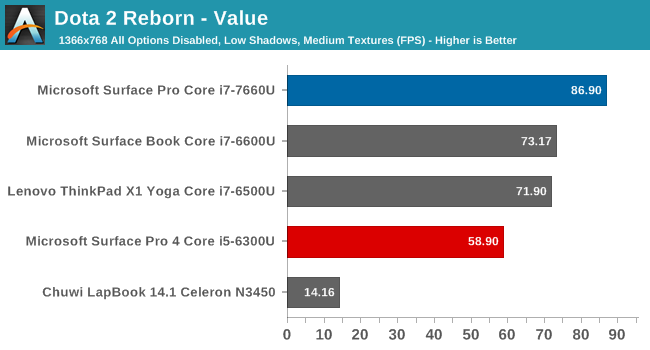
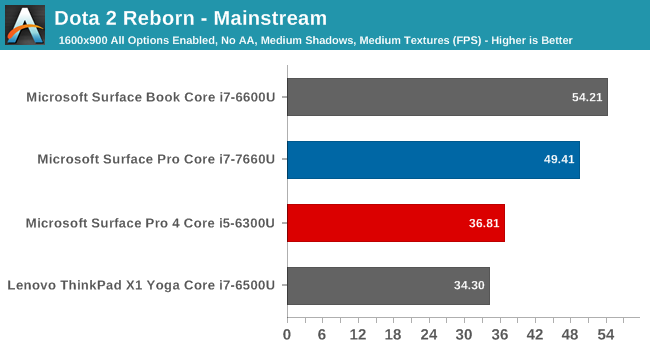
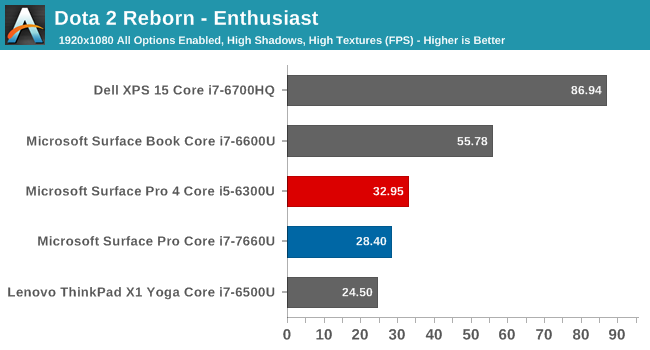
Here the Iris Plus Graphics do not bring the kind of improvement that would have been hoped for. At lower settings, they are very capable, and the extra CPU speed from the i7-7660U helps break the CPU bound barrier of the other systems, but once the graphics are turned up, the U series chip runs into the thermal barrier of only having a 15-Watt TDP. Compared to the Microsoft Surface Book, with it’s discrete GT 940M GPU, there’s really no contest, since that GPU alone would have 20-30 Watts of TDP available to it. The Iris does allow a lot more graphics potential, but for longer duration requirements, it may not offer much of an upgrade.
Graphics Conclusion
It’s great to finally be able to test a system with a U Series CPU and Iris graphics, and the results are quite impressive. It’s not quite up to par with even a low-end discrete GPU, but compared to the other integrated GPUs available in the other Ultrabooks, the Iris really brings the performance up a step. For light gaming, it should work well, but the extra eDRAM can help out on practically any task. The extra EUs available would also be of benefit to any productivity app that can leverage the GPU for some of its compute.
Storage Performance
PCIe SSDs have been the name of the game for the last couple of generations of Ultrabooks, but they’ve generally been shipping in the M.2 form factor. Microsoft has gone a different route with the new Surface Pro, by moving to a much smaller BGA SSD in the Samsung PM971.
The benefits of going this route are mostly packaging. The BGA SSD is significantly smaller than any M.2 SSD, especially the 2280 versions that are the most common. The drive is also most likely more energy efficient than the fastest SSDs available today, which should help with battery life.
There is likely only one downside to the PM971 BGA SSD, and that is performance. While still much faster than a SATA SSD, the PM971 is limited to a PCIe 3.0 x2 link, which is going to impact the maximum read and write speeds.
As you can see in the CrystalDiskMark test, the maximum read speed is well under something like a Samsung SM961. This may seem like bad news, but in fact the PM971 actually outperforms the same size PM951 drive which was easily the most popular SSD found in Ultrabooks until recently. The PM971 is 48 layer TLC NAND, with reasonable write speeds, and other than the lowered maximums created by the PCIe link being x2 instead of x4, the performance is quite good.
When you look at a device like the Surface Pro, where space is at a premium, these are the kinds of compromises that make sense when you consider that they’ve increased the battery capacity by 15%, and despite going with a compact SSD, they’ve still increased performance over the outgoing model assuming it had a PM951, which it seemed most did.


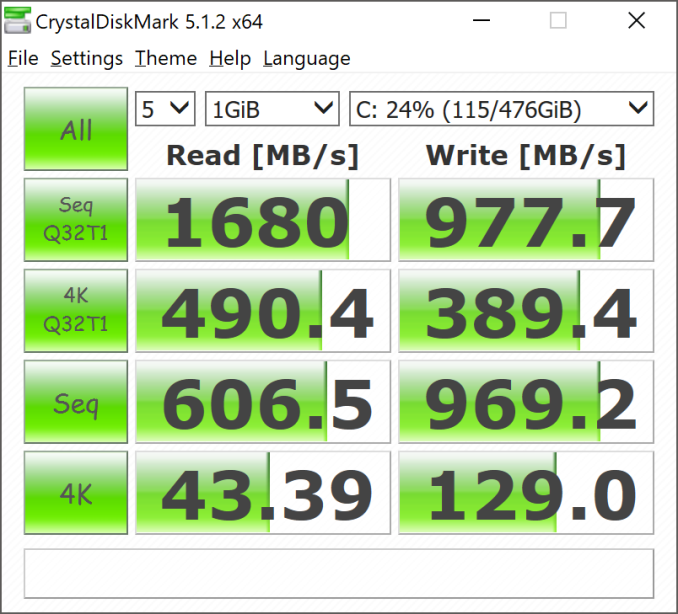








124 Comments
View All Comments
ivan.lazarenko - Friday, June 16, 2017 - link
Brett, thank you for the great review! This evolution approach for new Microsoft Surface Pro is a pretty lame version of what the fans were expecting to be a true successor, the real Surface Pro 5You might like this video hits like the last nail in the coffin and is funny: https://www.youtube.com/watch?v=f3sC82vnR7A
UtilityMax - Saturday, June 17, 2017 - link
I have never been fan of a "laptop" that's as unstable on your laps as the Surface Pro 4, and a "tablet" that's as thick as heavy as the Surface Pro, and with such relatively poor touch GUI and the lack of much tablet apps. In other words, it was a poor laptop, and a poor tablet. The new one looks like more of the same. I'd rather by myself a Lenovo Yoga 700 or 900-series ultra-tin laptops foldable keyboard (yes, real keyboard, not keyboard "covers")serendip - Saturday, June 17, 2017 - link
Unfortunately yes, most tablets make poor laptops. Large Windows tablets also make poor tablets because they're heavy and Windows still isn't touch friendly. I'm a masochist who loves traveling light so I don't mind rocking a cheap Teclast Windows tablet. I couldn't justify spending on a Surface when it costs so much and it doesn't know what it is.damianrobertjones - Friday, August 18, 2017 - link
Why does it have to be defined as either one?mkozakewich - Saturday, June 17, 2017 - link
Okay, so there's never been anything more than rhetoric flying around about the pens. "Oh, it's so much better now!" It sounds good, but then I also hear people swear by the Apple Pencil. Is it possible to benchmark those kinds of things? Would it be possible for you to measure activation forces various pens, as well as maybe latency and pressure-levels-per-gram-of-force?Also, was the original Type Cover Alcantara? I haven't seen a word of it, but that material really surprised me when I first encountered it. It seems like it couldn't have been, because everyone is going gaga over this iteration.
Brett Howse - Saturday, June 17, 2017 - link
I haven't used the Apple Pencil for a while now, but it seems like both are pretty close in terms of usability. We can measure some of the things you mentioned, but not all, at least without new equipment which would have limited value outside of testing a stylus. But I don't have the Apple Pencil to compare it against anyway.The original Type Cover was not Alcantara, although they did release a Signature version with the synthetic fabric after the Surface Pro 4 launched.
Bullwinkle J Moose - Saturday, June 17, 2017 - link
About AnandTechA Message from Our Founder, Anand Shimpi
We are motivated by one thing and one thing only: doing right by you.
--------------------------------------------------------------------------------------
AWESOME!
Can you please investigate my claims that this Laptop is using a Gov't Sponsored Spyware Platform "OR" provide "ANY" EVIDENCE that these claims are incorrect without simply deleting my posts without explanation?
I will gladly provide hundreds of examples of spyware/extortionware and malware if you like
Can't wait for an HONEST review
THANKS!
Bullwinkle J Moose
mrbofus - Saturday, June 17, 2017 - link
"But it seems like wasted space to offer a mini DisplayPort connecter over a USB-C port which could easily handle DisplayPort duties (and so much more). But it seems like wasted space to offer a mini DisplayPort connecter over a USB-C port which could easily handle DisplayPort duties (and so much more). "It would also be nice if they got rid of the proprietary power connector and used USB-C. Two full USB-C ports and a USB-A port would have been a perfect port combination, in my opinion.
simard57 - Wednesday, June 21, 2017 - link
as someone that trips over the power cable too often, I appreciate the magnetic connector.do agree with the comment regarding replacing Mini Display Port with USB-C but that would be dependent on cost impact.
Gunbuster - Saturday, June 17, 2017 - link
Can you test Wi-Fi with Bluetooth in use? I'm wondering if they ever fixed the (extra) poor performance with it doing both...